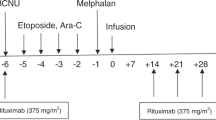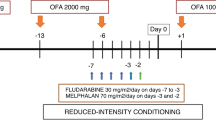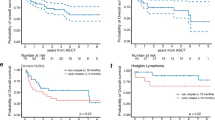Abstract
To better define the role of rituximab in salvage and high-dose therapy (HDT) for relapsed or refractory non-Hodgkin’s lymphoma (NHL), patients treated before the implementation of rituximab in salvage and HDT (n=57, control group) were compared with patients with rituximab included in this procedure (n=36, study group). All patients had been antibody-naive at this point, and analyses were performed separately for 22 and 31 patients with aggressive, and 14 and 26 patients with indolent NHL, respectively. All patients received two courses of salvage therapy, predominantly dexamethasone, BCNU, etoposide, cytosine arabinoside, melphalan. Conditioning regimens included BCNU, etoposide, cytosine arabinoside, melphalan; BCNU, etoposide, cytosine arabinoside, cyclophosphamide or total body irradiation and cyclophosphamide, with rituximab added for patients in the study group. Despite the absence of differences in stem cell collection, haematopoietic recovery was delayed in patients with aggressive NHL treated in the study group: median days to absolute neutrophil count more than 0.5×109/l, 11 vs 10 (p=0.01), and platelets more than 20×109/l, 14 vs 11 (p=0.0005), with an increased requirement for platelet transfusions. No similar observations were made in indolent lymphoma patients. Remission rates were superior for patients with aggressive NHL in the study group. With a median follow-up of 7.25 and 4.5 years, this resulted in an improvement in OS at 4.5 years: 67 vs 45% (95% confidence interval, 47–87% vs 28–64%; p=0.0468). For patients with indolent lymphoma, no comparable benefit was detectable. Our data support the use of rituximab in HDT for patients with aggressive NHL. For patients with indolent NHL, only longer follow-up and/or randomized trials may help to fully determine the impact of rituximab on the outcome after HDT.



Similar content being viewed by others
References
Philip T, Guglielmi C, Hagenbeek A, Somers R, Van der LH, Bron D et al (1995) Autologous bone marrow transplantation as compared with salvage chemotherapy in relapses of chemotherapy-sensitive non-Hodgkin’s lymphoma. N Engl J Med 333(23):1540–1545
Vose JM, Sharp G, Chan WC, Nichols C, Loh K, Inwards D et al (2002) Autologous transplantation for aggressive non-Hodgkin’s lymphoma: results of a randomized trial evaluating graft source and minimal residual disease. J Clin Oncol 20(9):2344–2352
Bosly A, Coiffier B, Gisselbrecht C, Tilly H, Auzanneau G, Andrien F et al (1992) Bone marrow transplantation prolongs survival after relapse in aggressive-lymphoma patients treated with the LNH-84 regimen. J Clin Oncol 10(10):1615–1623
Schouten HC, Bierman PJ, Vaughan WP, Kessinger A, Vose JM, Weisenburger DD et al (1989) Autologous bone marrow transplantation in follicular non-Hodgkin’s lymphoma before and after histologic transformation. Blood 74(7):2579–2584
Freedman AS, Neuberg D, Mauch P, Soiffer RJ, Anderson KC, Fisher DC et al (1999) Long-term follow-up of autologous bone marrow transplantation in patients with relapsed follicular lymphoma. Blood 94(10):3325–3333
Rohatiner AZ, Johnson PW, Price CG, Arnott SJ, Amess JA, Norton AJ et al (1994) Myeloablative therapy with autologous bone marrow transplantation as consolidation therapy for recurrent follicular lymphoma. J Clin Oncol 12(6):1177–1184
Horning SJ, Negrin RS, Hoppe RT, Rosenberg SA, Chao NJ, Long GD et al (2001) High-dose therapy and autologous bone marrow transplantation for follicular lymphoma in first complete or partial remission: results of a phase II clinical trial. Blood 97(2):404–409
Schouten HC, Qian W, Kvaloy S, Porcellini A, Hagberg H, Johnson HE et al (2003) High-dose therapy improves progression-free survival and survival in relapsed follicular non-Hodgkin’s lymphoma: results from the randomized European CUP trial. J Clin Oncol 21(21):3918–3927
Maloney DG, Liles TM, Czerwinski DK, Waldichuk C, Rosenberg J, Grillo-Lopez A et al (1994) Phase I clinical trial using escalating single-dose infusion of chimeric anti-CD20 monoclonal antibody (IDEC-C2B8) in patients with recurrent B-cell lymphoma. Blood 84(8):2457–2466
Maloney DG, Grillo-Lopez AJ, White CA, Bodkin D, Schilder RJ, Neidhart JA et al (1997) IDEC–C2B8 (rituximab) anti-CD20 monoclonal antibody therapy in patients with relapsed low-grade non-Hodgkin’s lymphoma. Blood 90(6):2188–2195
Davis TA, Grillo-Lopez AJ, White CA, McLaughlin P, Czuczman MS, Link BK et al (2000) Rituximab anti-CD20 monoclonal antibody therapy in non-Hodgkin’s lymphoma: safety and efficacy of re-treatment. J Clin Oncol 18(17):3135–3143
Czuczman MS, Weaver R, Alkuzweny B, Berlfein J, Grillo-Lopez AJ (2004) Prolonged clinical and molecular remission in patients with low-grade or follicular non-Hodgkin’s lymphoma treated with rituximab plus CHOP chemotherapy: 9-year follow-up. J Clin Oncol 22(23):4711–4716
Coiffier B, Lepage E, Briere J, Herbrecht R, Tilly H, Bouabdallah R et al (2002) CHOP chemotherapy plus rituximab compared with CHOP alone in elderly patients with diffuse large-B-cell lymphoma. N Engl J Med 346(4):235–242
Marcus R, Imrie K, Belch A, Cunningham D, Flores E, Catalano J et al (2005) CVP chemotherapy plus rituximab compared with CVP as first-line treatment for advanced follicular lymphoma. Blood 105(4):1417–1423
Hiddemann W, Dreyling M, Forstpointner R, Kneba M, Woermann B, Lengfelder E et al (2003) Combined immunochemotherpy (R-CHOP) significantly improves time to treatment failure in first line therapy of follicular lymphoma. Results of a prospective randomized trial of the German Low Grade Lymphoma Study Group (GLSG). Blood 102:352a
Pfreundschuh M, Truemper L, Devinder G (2004) First analysis of the completed Mabthera international (MINT) trial in young patients with low-risk diffuse large-B-cell lymphoma: addition of rituximab to a CHOP-like regimen significantly improves outcome of all patients with the identification of a very favorable subgroup with IPI=0 and no bulky disease. Blood 104:157a
Forstpointner R, Dreyling M, Repp R, Hermann S, Hanel A, Metzner B et al (2004) The addition of rituximab to a combination of fludarabine, cyclophosphamide, mitoxantrone (FCM) significantly increases the response rate and prolongs survival as compared with FCM alone in patients with relapsed and refractory follicular and mantle cell lymphomas: results of a prospective randomized study of the German Low-grade Lymphoma Study Group. Blood 104(10):3064–3071
Buckstein R, Imrie K, Spaner D, Potichnyj A, Robinson JB, Nanji S et al (1999) Stem cell function and engraftment is not affected by “in vivo purging” with rituximab for autologous stem cell treatment for patients with low-grade non-Hodgkin’s lymphoma. Semin Oncol 26(5 Suppl 14):115–122
Magni M, Di Nicola M, Devizzi L, Matteucci P, Lombardi F, Gandola L et al (2000) Successful in vivo purging of CD34-containing peripheral blood harvests in mantle cell and indolent lymphoma: evidence for a role of both chemotherapy and rituximab infusion. Blood 96(3):864–869
Voso MT, Pantel G, Weis M, Schmidt P, Martin S, Moos M et al (2000) In vivo depletion of B cells using a combination of high-dose cytosine arabinoside/mitoxantrone and rituximab for autografting in patients with non-Hodgkin’s lymphoma. Br J Haematol 109(4):729–735
Hess G, Flohr T, Huber C, Kolbe K, Derigs HG, Fischer T (2003) Safety and feasibility of CHOP/rituximab induction treatment followed by high-dose chemo/radiotherapy and autologous PBSC-transplantation in patients with previously untreated mantle cell or indolent B-cell-non-Hodgkin’s lymphoma. Bone Marrow Transplant 31(9):775–782
Flohr T, Hess G, Kolbe K, Gamm H, Nolte H, Stanislawski T et al (2002) Rituximab in vivo purging is safe and effective in combination with CD34-positive selected autologous stem cell transplantation for salvage therapy in B-NHL. Bone Marrow Transplant 29(9):769–775
Gingrich RD, Ginder GD, Burns LJ, Wen BC, Fyfe MA (1990) BVAC ablative chemotherapy followed by autologous bone marrow transplantation for patients with advanced lymphoma. Blood 75(12):2276–2281
Cheson BD, Horning SJ, Coiffier B, Shipp MA, Fisher RI, Connors JM et al (1999) Report of an international workshop to standardize response criteria for non-Hodgkin’s lymphomas. NCI Sponsored International Working Group. J Clin Oncol 17(4):1244
Bosch F, Lopez-Guillermo A, Campo E, Ribera JM, Conde E, Piris MA et al (1998) Mantle cell lymphoma: presenting features, response to therapy, and prognostic factors. Cancer 82(3):567–575
Benekli M, Hahn T, Shafi F, Qureshi A, Alam AR, Czuczman MS et al (2003) Effect of rituximab on peripheral blood stem cell mobilization and engraftment kinetics in non-Hodgkin’s lymphoma patients. Bone Marrow Transplant 32(2):139–143
Hoerr AL, Gao F, Hidalgo J, Tiwari D, Blum KA, Mathews V et al (2004) Effects of pretransplantation treatment with rituximab on outcomes of autologous stem-cell transplantation for non-Hodgkin’s lymphoma. J Clin Oncol 22(22):4561–4566
Prince HM, Imrie K, Crump M, Stewart AK, Girouard C, Colwill R et al (1996) The role of intensive therapy and autologous blood and marrow transplantation for chemotherapy-sensitive relapsed and primary refractory non-Hodgkin’s lymphoma: identification of major prognostic groups. Br J Haematol 92(4):880–889
Khouri IF, Saliba RM, Hosing C, Okoroji GJ, Acholonu S, Anderlini P et al (2005) Concurrent administration of high-dose rituximab before and after autologous stem-cell transplantation for relapsed aggressive B-cell non-Hodgkin’s lymphomas. J Clin Oncol 23(10):2240–2247
Horwitz SM, Negrin RS, Blume KG, Breslin S, Stuart MJ, Stockerl-Goldstein KE et al (2004) Rituximab as adjuvant to high-dose therapy and autologous hematopoietic cell transplantation for aggressive non-Hodgkin lymphoma. Blood 103(3):777–783
Hainsworth JD, Litchy S, Shaffer DW, Lackey VL, Grimaldi M, Greco FA (2005) Maximizing therapeutic benefit of rituximab: maintenance therapy versus re-treatment at progression in patients with indolent non-Hodgkin’s lymphoma—a randomized phase II trial of the Minnie Pearl Cancer Research Network. J Clin Oncol 23(6):1088–1095
Vose JM, Bierman PJ, Enke C, Hankins J, Bociek G, Lynch JC et al (2005) Phase I trial of iodine-131 tositumomab with high-dose chemotherapy and autologous stem-cell transplantation for relapsed non-Hodgkin’s lymphoma. J Clin Oncol 23(3):461–467
Gordan LN, Grow WB, Pusateri A, Douglas V, Mendenhall NP, Lynch JW (2005) Phase II trial of individualized rituximab dosing for patients with CD20-positive lymphoproliferative disorders. J Clin Oncol 23(6):1096–1102
Acknowledgements
The authors would like to thank the nursing staff at the transplantation units and the out-patient service for their contribution to the care of the patients, the nurses at the study department and Dr. R. Lipold from the Institute of Medical Biostatistics, Epidemiology and Informatics (IMBEI) for statistical advice.
Author information
Authors and Affiliations
Corresponding author
Rights and permissions
About this article
Cite this article
Hess, G., Flohr, T., Kolbe, K. et al. Effect of rituximab on the long-term outcome after high-dose therapy for relapsed B-cell non-Hodgkin’s lymphoma. Ann Hematol 85, 769–779 (2006). https://doi.org/10.1007/s00277-006-0157-6
Received:
Accepted:
Published:
Issue Date:
DOI: https://doi.org/10.1007/s00277-006-0157-6




